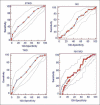Anatomic features of the neck as predictive markers of difficult direct laryngoscopy in men and women: A prospective study
- PMID: 24963183
- PMCID: PMC4050935
- DOI: 10.4103/0019-5049.130822
Anatomic features of the neck as predictive markers of difficult direct laryngoscopy in men and women: A prospective study
Erratum in
- Indian J Anaesth. 2015 Jan;59(1):63. Chara, Liaskou [corrected to Liaskou, Chara]; Eleftherios, Vouzounerakis [corrected to Vouzounerakis, Eleftherios]; Maria, Moirasgenti [corrected to Moirasgenti, Maria]; Anastasia, Trikoupi [corrected to Trikoupi, Anastasia]; Chryssoula, Staikou [corrected
-
Erratum: Anatomic features of the neck as predictive markers of difficult direct laryngoscopy in men and women: A prospective study: Erratum.Indian J Anaesth. 2015 Jan;59(1):63. doi: 10.4103/0019-5049.149468. Indian J Anaesth. 2015. PMID: 25687794 Free PMC article.
Abstract
Background and aims: Difficult airway assessment is based on various anatomic parameters of upper airway, much of it being concentrated on oral cavity and the pharyngeal structures. The diagnostic value of tests based on neck anatomy in predicting difficult laryngoscopy was assessed in this prospective, open cohort study.
Methods: We studied 341 adult patients scheduled to receive general anaesthesia. Thyromental distance (TMD), sternomental distance (STMD), ratio of height to thyromental distance (RHTMD) and neck circumference (NC) were measured pre-operatively. The laryngoscopic view was classified according to the Cormack-Lehane Grade (1-4). Difficult laryngoscopy was defined as Cormack-Lehane Grade 3 or 4. The optimal cut-off points for each variable were identified by using receiver operating characteristic analysis. Sensitivity, specificity and positive predictive value and negative predictive value (NPV) were calculated for each test. Multivariate analysis with logistic regression, including all variables, was used to create a predictive model. Comparisons between genders were also performed.
Results: Laryngoscopy was difficult in 12.6% of the patients. The cut-off values were: TMD ≤7 cm, STMD ≤15 cm, RHTMD >18.4 and NC >37.5 cm. The RHTMD had the highest sensitivity (88.4%) and NPV (95.2%), while TMD had the highest specificity (83.9%). The area under curve (AUC) for the TMD, STMD, RHTMD and NC was 0.63, 0.64, 0.62 and 0.54, respectively. The predictive model exhibited a higher and statistically significant diagnostic accuracy (AUC: 0.68, P < 0.001). Gender-specific cut-off points improved the predictive accuracy of NC in women (AUC: 0.65).
Conclusions: The TMD, STMD, RHTMD and NC were found to be poor single predictors of difficult laryngoscopy, while a model including all four variables had a significant predictive accuracy. Among the studied tests, gender-specific cut-off points should be used for NC.
Keywords: Height-to-thyromental distance ratio; laryngoscopy; neck circumference; sternomental distance; thyromental distance.
Conflict of interest statement
Figures


References
-
- Niven AS, Doerschug KC. Techniques for the difficult airway. Curr Opin Crit Care. 2013;19:9–15. - PubMed
-
- Samsoon GL, Young JR. Difficult tracheal intubation: A retrospective study. Anaesthesia. 1987;42:487–90. - PubMed
-
- Cormack RS, Lehane J. Difficult tracheal intubation in obstetrics. Anaesthesia. 1984;39:1105–11. - PubMed
-
- Shiga T, Wajima Z, Inoue T, Sakamoto A. Predicting difficult intubation in apparently normal patients: A meta-analysis of bedside screening test performance. Anesthesiology. 2005;103:429–37. - PubMed
-
- Crosby ET, Cooper RM, Douglas MJ, Doyle DJ, Hung OR, Labrecque P, et al. The unanticipated difficult airway with recommendations for management. Can J Anaesth. 1998;45:757–76. - PubMed
LinkOut - more resources
Full Text Sources
Other Literature Sources

